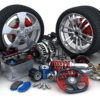How to Choose the Right Replacement Parts for Your Car’s Body
When it comes to maintaining or repairing your vehicle, choosing the right replacement parts for the car’s body is essential for both safety and appearance. Whether you’re dealing with minor damage, a major accident, or simply looking to upgrade your vehicle, selecting the right body parts can make a significant difference. But with so many options available, how do you make the right choice?
In this blog, we’ll guide you through the process of selecting the right replacement parts for your car’s body, ensuring a proper fit, quality, and performance.
1. Understand OEM vs. Aftermarket Parts
One of the first decisions you’ll face is choosing between OEM (Original Equipment Manufacturer) parts and aftermarket parts.
- OEM Parts: These are produced by the same manufacturer that made the original parts for your car. They are guaranteed to fit and function exactly like the original. While they may be more expensive, OEM parts offer peace of mind in terms of quality, warranty, and perfect fit.
- Aftermarket Parts: These are produced by third-party companies and can vary widely in quality and price. While some aftermarket parts are as good or better than OEM parts, others may not fit perfectly or have lower durability. However, aftermarket parts are often more affordable and easier to find.
2. Ensure Proper Fit and Compatibility
Not all car body parts are universal, so it’s crucial to choose parts specifically designed for your make, model, and year. Incorrectly fitting parts can lead to functionality issues, compromise your car’s safety, or make installation difficult. Before purchasing, double-check the part’s compatibility by referring to the vehicle’s VIN (Vehicle Identification Number), or consult a trusted professional or dealership.
3. Consider the Material
Car body parts come in various materials, and the right one depends on your needs, budget, and preferences. Common materials include:
- Steel: Durable and strong, steel is commonly used for parts like fenders and bumpers. However, it can be heavier and prone to rust over time.
- Aluminum: Lightweight and resistant to rust, aluminum parts are often used in modern vehicles. They can improve fuel efficiency but might be more expensive.
- Plastic/Polymer: Used in parts like bumpers and trim, plastic parts are lightweight and affordable, but they may not be as durable as metal.
4. Check for Certifications
When buying replacement parts, look for certified products to ensure you’re getting high-quality and safe components. Several organizations certify car body parts for safety and quality, including:
- CAPA (Certified Automotive Parts Association): This non-profit organization certifies aftermarket parts to ensure they meet or exceed industry standards.
- NSF (National Sanitation Foundation): The NSF certifies aftermarket parts for performance, safety, and fitment.
Buying certified parts can give you confidence that your replacement body parts will fit properly, perform well, and be safe for use.
5. Consider Price vs. Value
While it’s tempting to go for the cheapest option, remember that low-quality parts can lead to poor performance, additional repairs, or even safety risks. Evaluate the cost of the part against its durability and quality. In many cases, spending a little more on a high-quality part can save you money in the long run.
- OEM parts typically cost more but are guaranteed to match the original specifications.
- Aftermarket parts might offer better value if you’re not concerned about brand matching but be cautious about overly cheap alternatives.
6. Look for Warranties and Return Policies
Reliable car body part manufacturers and sellers often provide warranties on their products. A good warranty can protect you from defects or poor performance, giving you peace of mind when making a purchase. Similarly, check the return policy of the seller, especially if you’re unsure whether the part will fit your vehicle or meet your expectations.
7. Inspect the Part Before Installation
Once you’ve received the part, thoroughly inspect it for damage, flaws, or incorrect sizing before installation. A minor defect in the part could lead to major issues down the road. It’s better to catch any issues early rather than discover them after the part has been installed.
8. Choose a Trusted Supplier
Where you buy your parts is just as important as the parts themselves. Stick to reputable suppliers, whether online or in-store, to ensure you’re getting genuine, high-quality products. A trusted supplier will offer customer support, guidance on part selection, and fair return policies.
- Dealerships are a reliable source for OEM parts but may charge more.
- Auto parts stores offer a mix of OEM and aftermarket options and may provide professional advice.
- Online retailers often provide competitive pricing but make sure they’re well-reviewed and offer reliable shipping and return policies.
9. Consult a Professional Mechanic
If you’re unsure about what part to buy or how to install it, consulting with a professional mechanic can save you time and potential headaches. An experienced mechanic can help you choose the right part, install it correctly, and ensure that everything works as intended.
Conclusion
Choosing the right replacement parts for your car’s body is a critical step in maintaining its performance, safety, and appearance. By understanding the differences between OEM and aftermarket parts, checking for proper fit and certification, and considering the material and price, you can make a well-informed decision. Always buy from trusted suppliers and consult professionals if needed to keep your car looking and running great for years to come.
Categories
Recent Posts
Posts Widget








